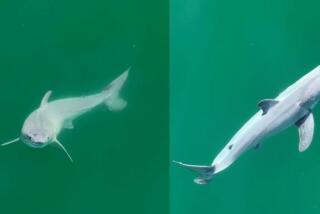Video: A ‘leg up’ in evolution? Watch this fish walk on land

A Polypterus senegalus fish walks across a sandy substrate. The bichir fish use their fins and body together to move across land, but they’re better at it if they’re raised outside of water, a study in Nature finds. (Credit: E.M. Standen and T.Y. Du)
Sometimes a fish out of water really can do better on land! Scientists studying a strange fish called a bichir from riverbanks in Africa have found that when they raise these so-called dragon fish in a terrestrial environment, their bodies actually change in ways that make them more successful walkers.
The findings, published online by the journal Nature, show that this sort of plasticity could have helped the ancient, long-gone fish species that crawled onto land adapt and eventually evolve into land-living creatures.
The first land-dwelling vertebrate animals are thought to have evolved from lobe-finned fishes about 400 million years ago. These animals gave rise to the tetrapods – the group that includes all birds, reptiles, amphibians and mammals, including humans. But understanding how those first fish took that evolutionary and literal step is a puzzle that scientists are still trying to piece together.
For this paper, Canadian researchers from the University of Ottawa and McGill University decided to study a fish species known as Polypterus senegalus, a fish that has lungs as well as gills – which means it can also breathe on land. It can even use its fins to crawl in a snake-like S shape – much in the way researchers think those first fishy tetrapod ancestors, the “fishapods,” first walked the Earth.
There are certainly other fascinating fish that can navigate terrain using agile fins – and they might even be better at it. But the bichir is the closest living relative to the common ancestor of lobe-finned fishes (which gave rise to tetrapods) and ray-finned fishes (almost all the fish in today’s oceans, lakes and rivers). Thus, studying it could provide some insight into the evolutionary transition that led from sea creatures to land animals like us.
The researchers raised a group of bichirs for eight months in a very damp but entirely land-locked environment, and raised another group in a watery one. At the end, they tested each group’s walking abilities by letting them go on a rough plastic surface and recording their progress on camera.
The fish that had grown up as landlubbers turned out to be far better at walking than their water-dwelling counterparts. They took faster steps, their fins ‘slipped’ on the surface less often, they held their fins closer to their bodies and could hold their heads higher as they walked.
“These were behaviours that the authors had predicted should develop to enhance walking abilities on land,” John Hutchinson of the Royal Veterinary College in England, who was not involved in the paper, wrote in a commentary.
But the effects went even deeper. The bichirs also underwent significant changes in muscle and even bone – alterations that probably helped them better resist gravity. For example, they found that the shape of the bone between the neck and the fin changed to allow the fin a wider range of independent movement – good for navigating terrain.
Their bodies were actually responding to the demands from their environment – a phenomenon called “developmental plasticity.”
Now, evolutionary change still takes many generations upon generations to take place. But this kind of plasticity could have given the fishapods a leg-up, so to speak, in eventually becoming the Earth’s first tetrapods, researchers said.
“The same type of plastic developmental mechanism that bichirs use today to make tentative, floppy incursions of the terrestrial realm might have been harnessed by our own fishapod forebears,” Hutchinson wrote, “leaving a much more revolutionary dynasty on Earth.”
Fascinated by evolution? Follow @aminawrite for more science news.







